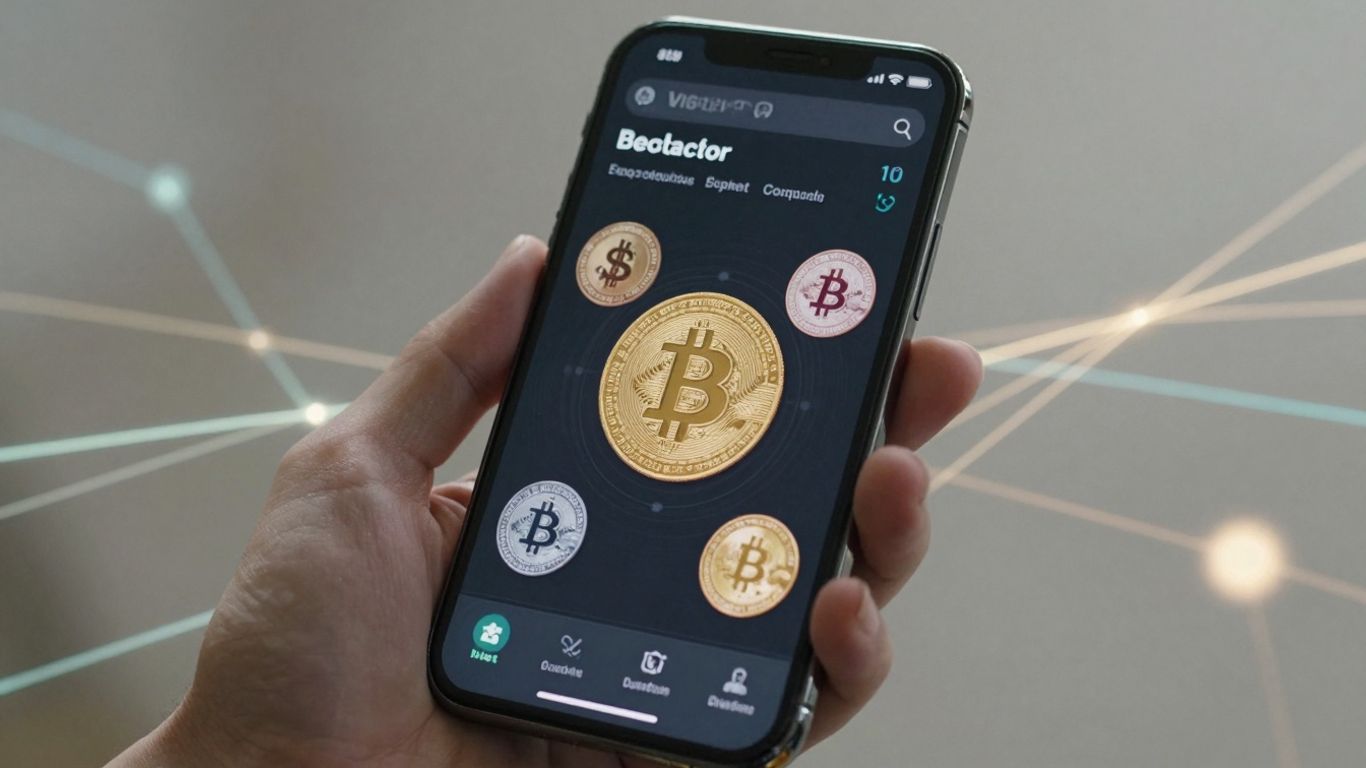[ newsletter ]
Stay ahead of Web3 threats—subscribe to our newsletter for the latest in blockchain security insights and updates.
Thank you! Your submission has been received!
Oops! Something went wrong. Please try again.
Explore the intricacies of flow of funds tracing, identifying sources and sinks of illicit crypto. Learn advanced techniques and challenges in financial crime units.





Following the money, or rather, the crypto, is a big deal these days. Whether it's for legitimate business or, well, less legitimate reasons, understanding where digital funds come from and where they end up is super important. This whole process, known as flow of funds tracing, helps us keep tabs on financial activity. It's like being a detective, but instead of footprints, you're looking at transaction records on the blockchain. We'll break down how this tracing works, looking at the sources of money and where it eventually gets parked, or 'sunk'.

Flow of funds tracing is basically about following the money, especially when it comes to figuring out where illicit cash ends up. Think of it like a detective story, but instead of clues at a crime scene, we're looking at digital trails left behind on blockchains. It's a pretty complex puzzle, and understanding the basics is key to getting a handle on how it all works.
In the world of financial flows, we talk about 'sources' and 'sinks'. A source is where the money starts, like a wallet that just received funds from a questionable activity. A sink, on the other hand, is where the money is headed, a place where it might be harder to track or where it's being converted into something else. Identifying these points is the first step in tracing any flow.
The goal is to map out the entire journey of funds, from their initial point of origin to their final resting place, or at least the last point where they can be clearly identified.
Blockchains, especially public ones, offer a unique advantage for tracing funds. Because transactions are recorded permanently and publicly, they create a trail that can be analyzed. Tools and platforms now exist that specialize in sifting through this data, making it possible to follow funds across different wallets and even different blockchains. This transparency, while sometimes seen as a privacy concern, is actually a powerful tool for investigators. For example, the T3 Financial Crime Unit has used blockchain intelligence to freeze millions in illicit assets.
When we analyze transactions, a few concepts pop up regularly. We look at transaction volume, the types of assets being moved, and the relationships between different wallet addresses. We also consider the speed of transactions; for instance, the speed and efficiency of crypto transfers can make it challenging for law enforcement to intervene quickly. Some key elements include:
uniqueIdentifier system.When we talk about tracing funds, figuring out where the bad money actually comes from is step one. It's not always obvious, and criminals are always finding new ways to hide their tracks. But there are some common places these illicit funds pop up.
Governments and international bodies put sanctions on certain countries, organizations, or individuals to limit their financial activities. Unfortunately, some of these sanctioned entities still try to use cryptocurrency to get around these restrictions. This can involve moving large amounts of crypto, often through less regulated exchanges or mixers, to fund their operations or evade financial scrutiny. In 2024, sanctioned entities were a big source of illicit crypto volume, even though the total amount decreased from the previous year. Exchanges like Garantex and Nobitex were major hubs for this activity.
Ransomware attacks, where criminals lock up your data and demand payment, have been a huge problem. They often demand payment in cryptocurrency because it's harder to trace than traditional money. Similarly, crypto-related hacks, like the ones that stole billions in 2024, directly generate illicit funds. These attacks can target individuals, companies, or even entire DeFi protocols, with attackers looking to exploit vulnerabilities to steal assets.
This is a broad category, but it covers a lot of ground. Think about "pig butchering" scams, where criminals build fake relationships to trick people into investing in non-existent opportunities. Then there are crypto drainers, which trick users into connecting their wallets to malicious sites to steal their funds. Address poisoning attacks, where scammers send tiny amounts of crypto to a target's address to trick them into sending funds back to the scammer's wallet, are also on the rise. While the overall volume of scam and fraud might have seen a dip in some reports, these schemes are still a major source of illicit funds, with billions still being funneled into scam addresses annually.
The sophistication of scams is increasing. We're seeing more professionalized operations that offer a full suite of illicit services, from the tech needed to launch scams to money laundering to help criminals cash out. This makes tracing the origin of these funds even more challenging.
Here's a look at some common sources:
Understanding these origins is the first step in disrupting the flow of illicit funds and holding criminals accountable.
When illicit funds start moving, they rarely stay in one place for long. Criminals often use a series of intermediaries to obscure the trail, making it harder for investigators to follow. These intermediaries can be anything from simple crypto wallets to more complex decentralized services. Understanding how these hops work is key to unraveling the flow.
Decentralized services and blockchain bridges are becoming increasingly popular tools for criminals looking to launder money. These services allow for the movement of assets across different blockchains or through complex smart contract interactions, adding layers of obfuscation. For instance, a criminal might move funds from Bitcoin to Ethereum using a bridge, then interact with various decentralized finance (DeFi) protocols. This makes tracking the money a lot more complicated because the transaction history gets fragmented across different networks.
The sheer volume and speed of transactions across multiple blockchains mean that manual tracing is often impossible. Sophisticated tools are needed to map these complex interconnections and identify patterns that might otherwise go unnoticed.
One of the defining characteristics of cryptocurrency is its speed. Transactions can be confirmed and settled in minutes, a stark contrast to traditional banking systems. This efficiency, while beneficial for legitimate users, also presents a significant challenge for law enforcement. Criminals can move vast sums of money across the globe almost instantaneously, often before authorities can even react. This rapid movement is particularly noticeable when funds are transferred between different blockchains using bridges or when they are quickly swapped on decentralized exchanges. The goal is often to reach a point where the funds are difficult to freeze or recover.
Combating sophisticated financial crime, especially in the crypto space, requires a united front. This is where public-private partnerships come into play. Agencies like law enforcement bodies are increasingly working with private companies that specialize in blockchain analytics. These collaborations are vital because private firms often have access to advanced tools and data that government agencies might not possess. For example, firms like TRM Labs provide blockchain intelligence platforms that help trace the source and destination of funds, identify illicit activities, and build cases. This partnership allows for a more effective and coordinated approach to tracking down criminals and recovering stolen assets. The T3 Financial Crime Unit, a collaboration involving TRON, Tether, and TRM Labs, is a prime example, demonstrating how joint efforts can freeze millions in illicit assets and dismantle criminal networks.

So, we've talked about where the money comes from, but what about where it ends up? That's where "sinks" come in. Think of them as the final resting places for illicit funds, or at least, places where they get harder to track. It's not always a simple case of "send it and forget it." Criminals use various methods to obscure the trail, and understanding these destinations is key to tracing the flow.
For a long time, centralized exchanges (CEXs) have been the go-to spot for criminals to offload stolen crypto. They offer a way to convert digital assets into fiat currency or other cryptocurrencies, often with less scrutiny than traditional financial institutions, though this is changing. Exchanges like Garantex and Nobitex, for instance, have been flagged for facilitating significant illicit volumes. While inflows to some of these have decreased, they remain a major hub for moving funds. It's a bit like a busy marketplace where dirty money can be cleaned, or at least mixed with legitimate transactions.
Things get a lot more interesting when we look at Decentralized Finance (DeFi). As CEXs tighten up, criminals are increasingly turning to DeFi protocols. This includes using decentralized services and blockchain bridges to move funds around, making them much harder to trace. We're seeing more varied decentralized services being used, and funds are being bridged more often than before. It's a dynamic landscape, and new patterns emerge constantly. For example, protocols that allow for complex swaps or liquidity provision can act as effective sinks, obscuring the origin of funds.
Stablecoins have become a really big deal in illicit finance. Because they're pegged to a stable asset like the US dollar, they offer price stability, which is super useful for criminals who want to avoid the volatility of other cryptocurrencies. They're efficient on various networks and have deep liquidity, making them ideal for laundering money. Reports show that stablecoins accounted for a huge chunk of illicit transaction volumes in 2024. This makes them a prime target for analysis when tracing funds.
The shift towards stablecoins in illicit activities highlights a strategic adaptation by criminals. They offer a blend of crypto's transactional advantages with the perceived safety of fiat currency, creating a potent tool for obfuscation and value preservation.
Here's a look at how some functions in smart contracts can act as sinks:
transfer(address, uint256): This is a pretty standard function for moving tokens. When illicit funds are sent to an address via this function, it can be considered a sink.transferFrom(address, address, uint256): Similar to transfer, but allows an authorized account to move funds. This adds a layer of complexity but still leads to a destination.withdraw(uint256): When funds are pulled out of a protocol or smart contract, this action can also serve as a sink, especially if the withdrawal is part of a laundering scheme.Understanding these destinations is just as important as knowing the sources. It's all part of piecing together the puzzle of illicit fund flows, and tools like blockchain forensics are invaluable in this process.
When the usual methods of tracking funds hit a wall, it's time to bring out the heavy artillery. This is where advanced techniques come into play, offering more sophisticated ways to follow the money, especially in the complex world of digital assets. These methods go beyond simple transaction history, digging deeper into the mechanics of blockchain and smart contracts.
Think of blockchain intelligence platforms as super-powered detective tools for the digital age. These platforms use advanced analytics, often powered by artificial intelligence, to sift through massive amounts of blockchain data. They can identify patterns, flag suspicious addresses, and even predict potential risks. These tools are becoming indispensable for law enforcement and financial institutions trying to stay ahead of illicit activities. They help connect the dots between seemingly unrelated transactions, providing a clearer picture of fund flows. For instance, platforms can track funds moving through sanctioned entities, which is a big deal given that sanctioned entities drove a significant amount of illicit crypto volume in 2024, even with a decline from the previous year. These systems are crucial for understanding market dynamics and protecting investors.
This technique is all about understanding how vulnerabilities in smart contracts can be exploited to move funds. It's like tracing a leak in a pipe to see where the water is going. Taint analysis tracks data as it flows through a smart contract, marking it as "tainted" if it originates from a potentially malicious source or is used in a way that could be exploited. This helps identify weaknesses before they can be used for theft. For example, issues like access control failures or logic errors in smart contracts have led to massive losses, such as the $223 million overflow exploit on the Sui network or the $49.5 million exploit due to overlooked admin privileges. By analyzing how data moves, we can spot these potential exploits. It's also about understanding how developers fix these issues, looking at commits that resolve vulnerabilities and seeing if they follow best practices or if there are new, valid fixes emerging.
Sometimes, funds get trapped in compromised wallets, often due to bots that instantly steal any incoming gas fees. This is where tools utilizing technologies like Flashbots come in. These tools can bundle transactions – like funding a wallet and then moving assets out – into a single, private package sent directly to miners. This bypasses the hacker's bots, allowing for the safe recovery of assets. It's a pretty neat trick to get your funds back when a wallet gets hacked. For instance, a wallet recovery solution can help transfer assets out of a compromised Ethereum wallet, bundling the funding and transfer into one atomic transaction. This process is key for incident response when traditional recovery methods fail because of those pesky bots monitoring compromised wallets 24/7.
Tracing funds in the crypto space isn't always straightforward, and honestly, it's getting more complicated by the day. Criminals are constantly finding new ways to move money around, making our jobs tougher. The speed and efficiency of crypto transfers are a major hurdle for law enforcement. It often feels like we're playing catch-up.
One big issue is how quickly funds can move across different blockchains and through decentralized services. These systems, like blockchain bridges, are designed to be fast and borderless, which is great for legitimate users but also a dream for illicit actors. They can move millions in just hours, making it incredibly difficult to freeze assets before they disappear. We're seeing a lot of this happening on networks like TRON, where illicit volume has seen some drops but still presents a challenge.
Here are some of the main difficulties we face:
Recovering stolen assets is a huge part of fund tracing, but it's often the hardest part. When funds are moved through mixers or privacy-focused protocols, or even just rapidly shuffled between many wallets, it becomes nearly impossible to pinpoint the original source or the final destination. We've seen cases where billions are stolen, but only a fraction can ever be recovered. It's a tough reality.
The constant innovation in blockchain technology, while beneficial for many, also presents new avenues for exploitation. As new protocols and services emerge, they often introduce novel attack vectors that security researchers and law enforcement are only beginning to understand. This creates a continuous cycle of adaptation and response.
We're seeing a shift in how criminals operate. Instead of relying on a few well-known methods, they're diversifying. For instance, while scam and fraud volumes might decline overall, specific types like pig butchering scams are growing, and they're adapting their strategies. They might be focusing on getting smaller payments from more victims, or using new tools like crypto drainers and address poisoning attacks. The use of stablecoins in illicit finance is also a growing concern, as they offer price stability and efficiency for criminal operations. We're also seeing more sophisticated attacks on DeFi protocols, like those involving flash loans and oracle manipulation, which can drain millions in minutes. Tools like Flashbots are being developed to help recover assets from hacked wallets, but this is more about damage control than preventing the initial theft.
Looking ahead, the key is staying ahead of the curve. This means not just reacting to incidents but proactively monitoring the entire ecosystem. Public-private partnerships are becoming more important than ever. Initiatives like the T3 Financial Crime Unit, which brings together law enforcement, stablecoin issuers, and blockchain analytics firms, are showing promise. They've managed to freeze significant amounts of illicit assets by combining real-time tracing with immediate freezing capabilities. This kind of collaboration is vital for building a more secure crypto future. We need to keep developing better tools, like advanced blockchain intelligence platforms, and adapt our strategies as criminals do. It's a constant race, but one we have to keep running. For more on tracing funds, check out this guide on successful funds tracing.
So, we've looked at how money moves around, where it comes from, and where it ends up. It's a bit like tracking a river, seeing all the streams that feed into it and where it eventually flows out. Sometimes it's straightforward, and other times, well, it gets pretty complicated, especially when folks try to hide things. Understanding these flows is super important, whether you're trying to keep your own digital assets safe or just trying to make sense of the bigger financial picture. It’s not always easy, and new challenges pop up all the time, but keeping track is key.
Imagine you have a trail of money, like breadcrumbs. Flow of funds tracing is like following those breadcrumbs to see where money comes from (the source) and where it ends up (the sink). This helps us understand how money moves, especially when it might be used for something bad.
Think of blockchain as a super secure, public diary where every money move is written down. Because it's shared and can't be easily changed, it makes it much easier to track where money has been, kind of like having a permanent record for everyone to see.
A 'source' is where the money starts – like someone sending money, or it coming from a specific place. A 'sink' is where the money finally stops or is hidden, like a special account or a service that makes it hard to trace further.
Unfortunately, no. Sometimes, once money is stolen and moved around a lot, especially through complex digital paths, it becomes very difficult or even impossible to get back. It's like trying to un-mix paint – very tricky!
Stablecoins are digital currencies designed to stay at a steady price, like $1. This makes them easy for criminals to use because they don't have to worry about the value changing wildly. They can move large amounts of money quickly without the value dropping, making them a popular choice for bad actors.
DeFi stands for Decentralized Finance. These are like financial services (like lending or trading) that run on blockchain without a central bank. They can be tricky to trace because they don't have one single company in charge. Criminals sometimes use them to hide or move stolen money in ways that are harder for regular tracking methods to follow.


